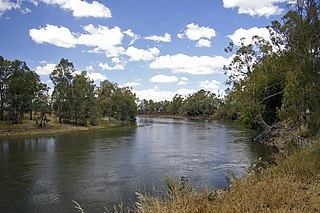Murrumbidgee River
Murrumbidgee River (/mʌrəmˈbɪdʒi/), a major tributary of the Murray River within the Murray–Darling basin and the second longest river in Australia. It flows through the Australian state of New South Wales and the Australian Capital Territory. It descends 1,500 metres (4,900 ft) as it flows 900 kilometres (559 mi) in a west-northwesterly direction from the foot of Peppercorn Hill in the Fiery Range of the Snowy Mountains towards its confluence with the Murray River near Boundary Bend.
The word Murrumbidgee means "big water" in the Wiradjuri language, one of the local Aboriginal languages. The river itself flows through several traditional Indigenous Australian lands, home to various Aboriginal tribes. In the Australian Capital Territory, the river is bordered by a narrow strip of land on each side, which are both managed as the ‘Murrumbidgee River Corridor’ (MRC). This land includes nature reserves, eight recreation reserves, a European heritage conservation zone and rural leases.
The mainstream of the river system flows for 900 kilometres (560 mi). The river's headwaters arise from the wet heath and bog at the foot of Peppercorn Hill situated along Long Plain which is within the Fiery Range of the Snowy Mountains; and about 50 kilometres (31 mi) north of Kiandra. From its headwaters it flows to its confluence with the Murray River. The river flows for 66 kilometres (41 mi) through the Australian Capital Territory near Canberra, picking up the important tributaries of the Gudgenby, Queanbeyan, Molonglo and Cotter Rivers. The Murrumbidgee drains much of southern New South Wales and all of the Australian Capital Territory, and is an important source of irrigation water for the Riverina farming area.
...
Wikipedia


